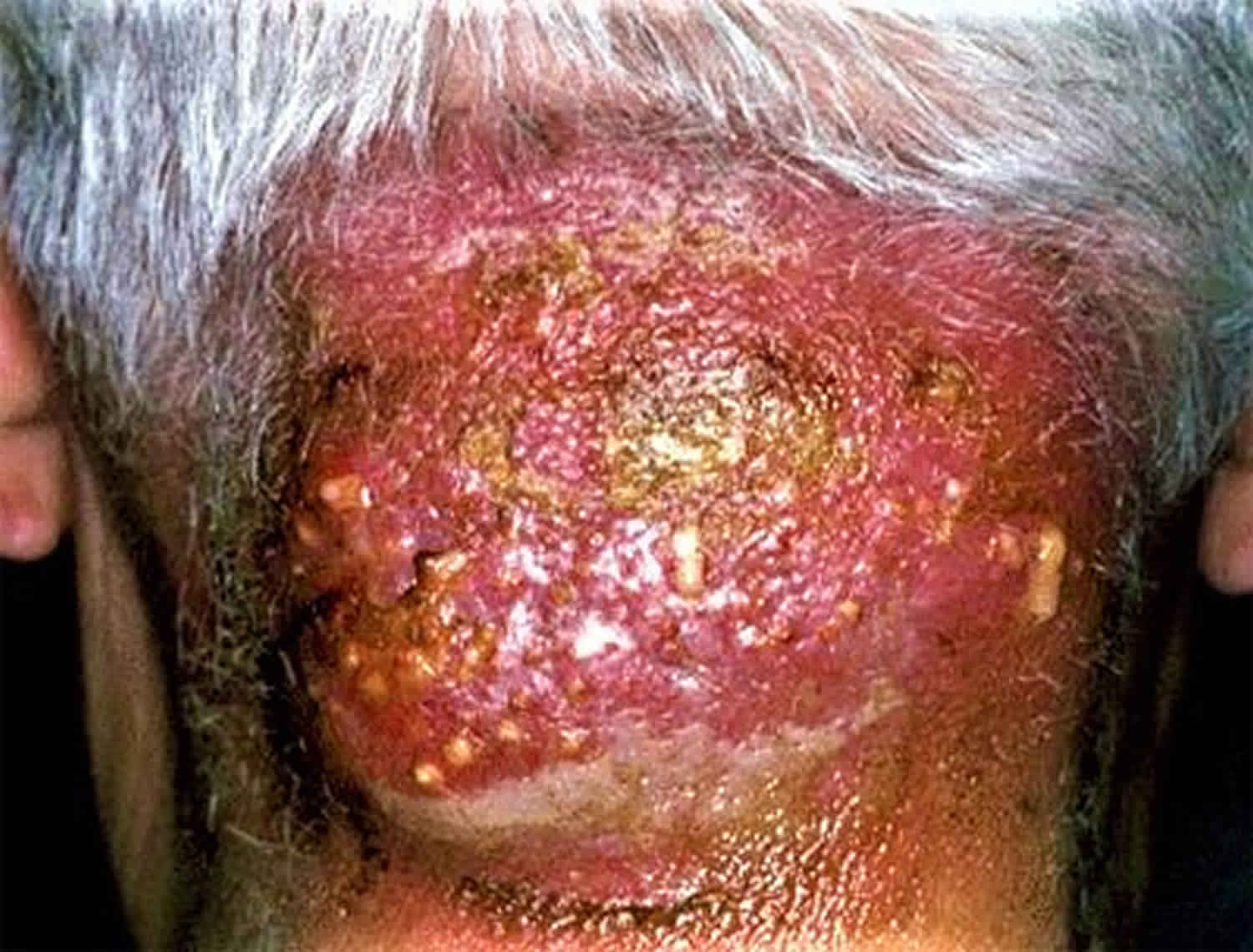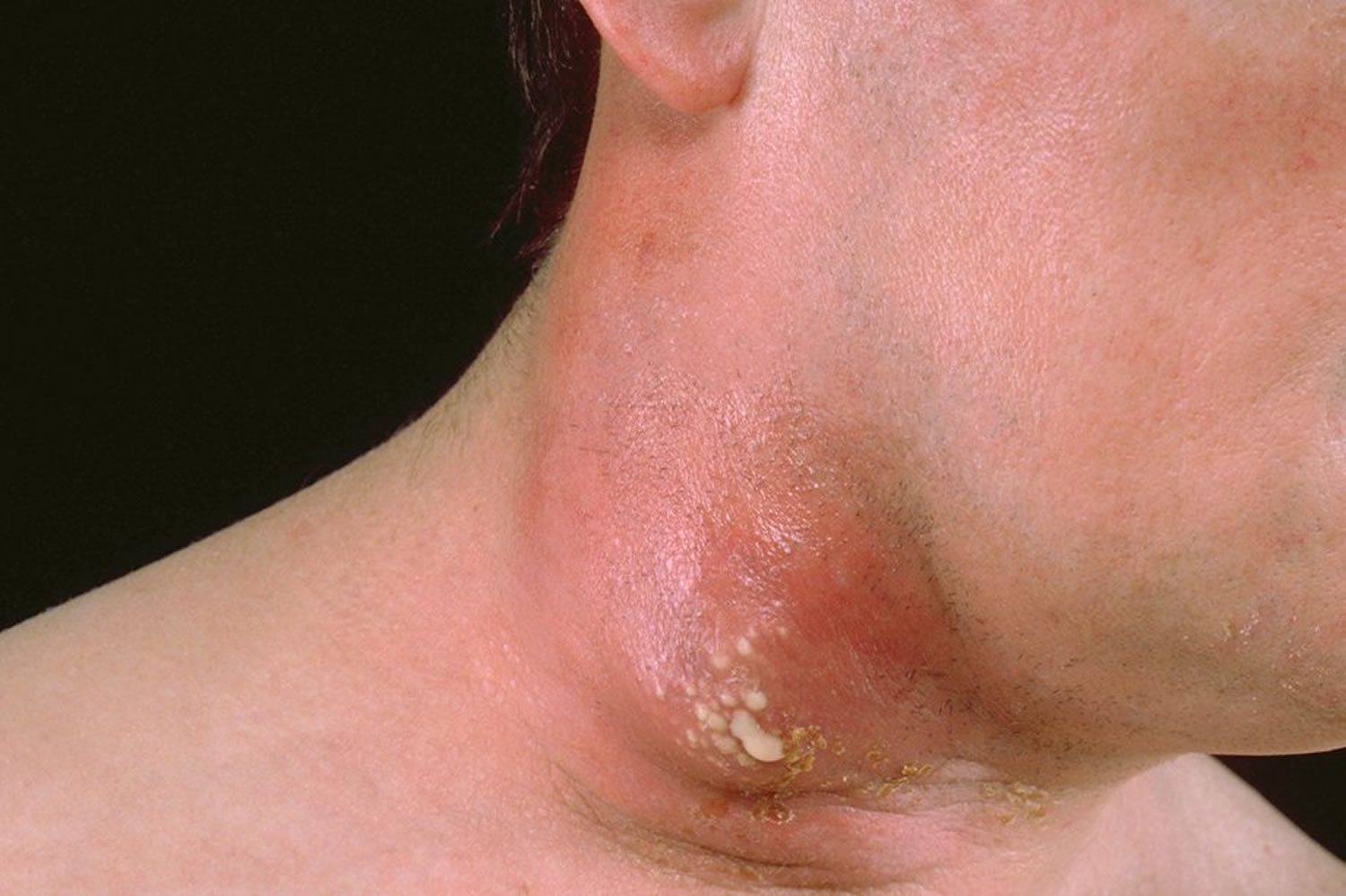What is carbuncle
A carbuncle is a dome-shaped cluster of boils (furuncles) that form a connected area of infection, that usually develops over a few days. A carbuncle is a coalescence of several inflamed hair follicles (boils or staphylococcal abscesses) into a single inflammatory mass with purulent drainage from multiple hair follicles. The infected mass is filled with fluid, pus, and dead tissue. Fluid may drain out of the carbuncle, but sometimes the mass is so deep that it cannot drain on its own. Carbuncles can develop anywhere. But they are most common on the back, shoulders, thighs, or back of the neck. Compared with single boils, carbuncles cause a deeper and more severe infection and are more likely to leave a scar. People who have a carbuncle often feel unwell in general and may experience a fever and chills. When a person has many carbuncles, the condition is called carbunculosis.
A carbuncle can grow to a size of 3-10 cm and will leak pus from a number of points.
You may also:
- have a high temperature of 100.4 °F (38 °C) or above
- feel generally unwell
- feel weak and exhausted
Carbuncles are less common than boils and tend to mostly affect middle-aged or older men in poor health or with a weakened immune system. Alcohol use disorder, malnutrition, impaired circulation, diabetes mellitus, and other forms of immunosuppression predispose an individual to carbuncles.
The bacteria that cause this condition spread easily. So, family members may develop carbuncles at the same time. Often, the cause of a carbuncle cannot be determined.
You are more likely to get a carbuncle if you have:
- Friction from clothing or shaving
- Poor hygiene
- Poor overall health
Staph bacteria are sometimes found in the nose. Carbuncles can recur when antibiotics are not able to treat the bacteria in the nose.
Further testing, such as a blood test or skin swab, may be needed if you have:
- a boil or carbuncle that keeps returning or doesn’t respond to treatment
- multiple boils or carbuncles
- a weakened immune system caused by a condition such as diabetes, or having a treatment such as chemotherapy
Community-associated methicillin-resistant Staphylococcus aureus (CA-MRSA) is a strain of staph bacteria resistant to antibiotics in the penicillin family, which have been the cornerstone of antibiotic therapy for staph and skin infections for decades. Community-associated methicillin-resistant Staphylococcus aureus previously infected only small segments of the population, such as health care workers and persons using injection drugs. However, community-associated methicillin-resistant Staphylococcus aureus is now a common cause of skin infections in the general population. While community-associated methicillin-resistant Staphylococcus aureus bacteria are resistant to penicillin and penicillin-related antibiotics, most staph infections with community-associated methicillin-resistant Staphylococcus aureus can be easily treated by health care practitioners using local skin care and commonly available non-penicillin-family antibiotics. Rarely, community-associated methicillin-resistant Staphylococcus aureus can cause serious skin and soft tissue (deeper) infections. Staph infections typically start as small red bumps or pus-filled bumps, which can rapidly turn into deep, painful sores. If you see a red bump or pus-filled bump on the skin that is worsening or showing any signs of infection (ie, the area becomes increasingly painful, red, or swollen), see your doctor right away. Many people believe incorrectly that these bumps are the result of a spider bite. Your doctor may need to test (culture) infected skin for MRSA (methicillin-resistant Staphylococcus aureus) before starting antibiotics. If you have a skin problem that resembles a community-associated methicillin-resistant Staphylococcus aureus infection or a culture that is positive for MRSA (methicillin-resistant Staphylococcus aureus), your doctor may need to provide local skin care and prescribe oral antibiotics. To prevent spread of infection to others, infected wounds, hands, and other exposed body areas should be kept clean, and wounds should be covered during therapy.
Figure 1. Carbuncle
See your doctor if you think you have a carbuncle.
With boils, you don’t usually need to see a doctor as most boils burst and heal by themselves. But see your doctor if you have a boil:
- on your face, nose or spine – this can sometimes cause serious complications
- that gets bigger and feels soft and spongy to touch – it may not burst and heal by itself
- is more than 2 inches (5 centimeters) across
- that doesn’t heal within two weeks
- and you have a temperature and feel generally unwell
Your doctor should be able to identify a boil or carbuncle by looking at it.
Can I catch a boil or carbuncle?
Yes, you can. Unlike acne, boils and carbuncles can spread to another part of the body or to another person.
To prevent boils and carbuncles spreading, take simple precautions such as:
- washing your hands after touching affected areas
- using a separate face cloth and towel
- washing underwear, bed linen and towels at a high temperature
- covering wounds with a dressing until they heal
- carefully disposing of used dressings
Why do boils occur?
Most people with boils are otherwise healthy and have good personal hygiene. They do however carry Staphylococcus aureus on the surface of their skin (staphylococcal carrier state). Why this occurs is usually not known, but it is estimated that 10–20% of the population are staphylococcal carriers.
Staphylococcus aureus is most commonly carried in the nostrils, armpits, between the legs and in the cleft between the buttocks. It may be transferred to other sites from the nostrils via the finger nails.
Tiny nicks or grazes or something rubbing against the skin can innoculate the bacteria into the wall of a hair follicle which is a weak point in the skin’s defences. Once innoculated, the bacteria cause a boil which goes on to run its usual course of about 10 days.
Although most people with boils are otherwise healthy, boils are sometimes related to immune deficiency, anaemia, diabetes, smoking or iron deficiency.
Carbuncle vs Boil
Boil also called a furuncle, is a painful pus-filled bump on the skin resulting from the deep infection of a hair follicle. Boil is a deep form of bacterial folliculitis (infection of a hair follicle). The infection is usually caused by a type of bacteria called Staphylococcus aureus (“staph”). Many people are “carriers” of the staph germ, meaning that it normally lives on their skin or in their nose without doing them any harm. Tiny breaks in the surface of the skin (such as those caused by friction or scratching), however, can help the germ gain entry into and infect the hair follicle, resulting in a boil.
Boils can develop anywhere on your skin, but you’re most likely to get one in an area where there’s a combination of hair, sweat and friction, such as the neck, face or thighs.
Over time, pus forms inside the boil, making it bigger and more painful. Most boils eventually burst and the pus drains away without leaving a scar. This can take from two days to three weeks to happen.
It can sometimes be difficult to tell the difference between a boil and a spot, but boils tend to grow bigger and become more painful. Your GP should be able to diagnose a boil from its appearance.
Boils may resolve with simple self-care measures, but the infected fluid (pus) needs to drain in order for them to heal completely. Many boils drain of their own accord, or they can be lanced by a health care professional. Antibiotics may also be prescribed. Untreated boils can enlarge or grow together to form a giant multi-headed boil (carbuncle). Rarely, the infection in the skin can get into the bloodstream, leading to serious illness.
Boils are most common in teenagers and young adults.
People that are particularly prone to developing boils include:
- Athletes participating in contact sports or using shared equipment.
- Individuals with a weakened immune system, such as persons with HIV, diabetics, and those taking certain medications such as the types of medications
- used to prevent rejection of a transplanted organ or to treat cancer (chemotherapy).
- Individuals with another skin condition that may lead to scratching or other injury to the skin (eczema, scabies).
- Staph carriers.
- People who are obese.
- Individuals with poor nutrition.
- People living in close quarters with others (military barracks, prison, homeless shelters).
Most boils get better without the need for medical treatment. One of the best ways to speed up healing is to apply a warm, moist face cloth to the boil for 10-20 minutes, three or four times a day. The heat increases the amount of blood circulating around the boil, which sends more infection-fighting white blood cells to the area.
When the boil bursts, cover it with sterile gauze or a dressing to prevent the spread of infection. Afterwards, wash your hands thoroughly using hot water and soap.
Never squeeze or pierce a boil because it could spread the infection.
You can use over-the-counter painkillers, such as acetaminophen or ibuprofen, to help relieve any pain caused by the boil.
Boil signs and symptoms
A red-to-purple, tender lump on an area of the skin that also has hair. The most common areas for boils to occur are places where there is friction and/or places that tend to be sweaty, such as the buttocks, armpits, groin, neck, shoulders, and face. The skin surrounding the lump may look swollen and red. The center of the lump eventually becomes filled with yellow or white pus that you will be able to see (called “coming to a head”). The pus is a mixture of bacteria and infection-fighting white blood cells.
Boil home remedy
Pus needs to drain before a boil will heal. This may happen by itself, but sometimes your doctor will need to treat it. Warm compresses applied to the area for 20 minutes at least 3–4 times a day may ease the discomfort and help encourage the boil to drain. If the boil starts to drain, wash the area with antibacterial soap and apply some triple antibiotic ointment and a loose bandage. Repeat this process of cleansing and bandaging the area 2–3 times a day until the skin is healed.
Boils can be very contagious. Do not share clothing, towels, bedding, or sporting equipment with others while you have a boil. Wash your hands frequently with antibacterial hand soap to avoid spreading the infection to others.
Use an antibacterial soap on boil-prone areas when showering, and dry your skin thoroughly after bathing. Avoid tight-fitting clothing and activities that cause a great deal of sweating.
Never squeeze or pierce a boil because it could spread the infection. Pus contains bacteria so avoid getting the pus from the boil onto other areas of the skin. If pus is discharged, wash the area around carefully with an antibacterial product and also wash the hands to avoid spreading the infection.
For larger furuncle, treatment may include:
- Incision and drainage. Your doctor may drain a large boil or carbuncle by making an incision in it. Deep infections that can’t be completely drained may be packed with sterile gauze to help soak up and remove additional pus.
- Antibiotics. Sometimes your doctor may prescribe antibiotics to help heal severe or recurrent infections.
See your doctor if:
- You have multiple boils (carbuncle) or if the boil(s) increases in size or number.
- You have a fever or chills, severe pain, or otherwise feel unwell.
- The boil fails to drain.
- The area of redness surrounding the boil begins spreading.
- You have diabetes, a heart murmur, a problem with your immune system, or are taking immune-suppressing medications when you develop a boil.
- You have had repeated outbreaks of boils.
If you are currently being treated for a skin infection that has not improved after 2–3 days of antibiotics, return to your doctor.
Carbuncle vs Furuncle
Furuncle is also called a boil. See above for detailed description of furuncle or boil. Furuncles (boils) are cutaneous abscesses associated with hair follicles. By definition, furuncles are of infectious etiology, with the most common causative agent being Staphylococcus aureus (either methicillin-sensitive [MSSA] or methicillin-resistant [MRSA]). The infecting strain of Staphylococcus is usually colonizing the nares, umbilicus, or perineum. Furunculosis most commonly affects adolescents and young adults and is rarely seen in childhood. It more commonly affects males. Predisposing factors include Staphylococcus carriage, friction, malnutrition, poor hygiene, possibly diabetes, hyper-IgE syndrome, and human immunodeficiency virus (HIV) infection.
Clinically, furuncles are painful (particularly when in the nose or ear canal). They often appear in crops. Patients may describe purulent drainage. They usually occur on the face, neck, axillae, buttocks, thighs, and perineum. When on the central face, cavernous sinus thrombosis is a rare complication. Lesions may continue to develop for months to years, but individual lesions often heal spontaneously within 2-3 weeks.
MRSA first emerged as an important nosocomial pathogen in the 1960s. In more recent years, community-acquired outbreaks of MRSA (CA-MRSA) have been described increasingly among healthy individuals lacking the traditional risk factors for such infections (e.g., IV drug use, incarceration, participation in contact sports). These strains have a propensity for causing abscesses, furunculosis, and folliculitis and have a unique antibiotic susceptibility profile from health care-associated strains of MRSA.
Immunocompromised patients have a significantly increased risk of developing both MSSA and MRSA furunculosis. HIV-infected patients are approximately 20 times more likely to develop skin and soft tissues infections caused by MRSA. Risk factors for MRSA infection in this population are low current CD4 cell count, recent beta-lactam antibiotic use, and high-risk sexual activity.
Carbuncle causes
Boils and carbuncles are often caused by a type of bacteria called Staphylococcus aureus (staph bacteria) that infects one or more hair follicles. Staph bacteria usually live harmlessly on the surface of the skin or in the lining of the nose. People with diabetes, dermatitis, and a weakened immune system are more likely to develop staph infections that can cause carbuncles.
You can get a boil when bacteria enter the skin through cuts and grazes. Your immune system responds by sending infection-fighting white blood cells to kill the bacteria.
Over time, a mixture of dead bacteria, dead white blood cells and dead skin cells builds up inside the boil to form pus.
A carbuncle develops when the infection spreads further beneath the skin to create a cluster of boils.
Risk factors for boils and carbuncles
Although anyone — including otherwise healthy people — can develop boils or carbuncles, the following factors can increase your risk:
- Close contact with a person who has a staph infection. You’re more likely to develop an infection if you live with someone who has a boil or carbuncle.
- Diabetes. This disease can make it more difficult for your body to fight infection, including bacterial infections of your skin.
- Other skin conditions. Because they damage your skin’s protective barrier, skin problems, such as acne and eczema, make you more susceptible to boils and carbuncles.
- Compromised immunity. If your immune system is weakened for any reason, you’re more susceptible to boils and carbuncles.
Carbuncle prevention
You can’t always avoid getting a boil or carbuncle, but these simple steps can reduce your risk:
- Wash your hand and skin regularly using a mild antibacterial soap. The most effective way is to wash hands often, and before and after touching broken skin.
- Carefully clean any cuts, wounds or grazes (even small ones)
- Cover cuts, wounds and grazes with a sterile bandage until they heal
- Eat healthily and exercise regularly to boost your immune system
- Keep personal items personal. Avoid sharing personal items, such as towels, sheets, razors, clothing and athletic equipment. Staph infections can spread via objects, as well as from person to person. If you have a cut or sore, wash your towels and linens using detergent and hot water with added bleach, and dry them in a hot dryer.
Carbuncle signs and symptoms
A carbuncle is a swollen lump or mass under the skin. It may be the size of a pea or as large as a golf ball. The carbuncle may be red and irritated and might hurt when you touch it.
A carbuncle usually:
- Develops over several days
- Have a white or yellow center (contains pus)
- Weep, ooze, or crust
- Spread to other skin areas
Sometimes, other symptoms may occur. These may include:
- Fatigue
- Fever
- General discomfort or sick feeling
- Skin itching before the carbuncle develops
Carbuncle complications
Although most boils and carbuncles don’t cause further problems, some people develop a secondary infection.
This can range from a relatively minor (though often very painful) infection of the deeper layer of the skin, such as cellulitis, to rarer and more serious complications, such as sepsis.
Larger boils and carbuncles can also lead to scarring.
Rarely, bacteria from a boil or carbuncle can enter your bloodstream and travel to other parts of your body. The spreading infection, commonly known as blood poisoning (sepsis), can lead to infections deep within your body, such as your heart (endocarditis) and bone (osteomyelitis).
Rare complications of carbuncles include:
- Abscess of the brain, skin, spinal cord, or organs such as the kidneys
- Endocarditis
- Osteomyelitis
- Permanent scarring of the skin
- Sepsis
- Spread of infection to other areas
Carbuncle diagnosis
Your doctor will likely be able to diagnose a boil or carbuncle simply by looking at it. He or she might suggest sending a sample of the pus to a lab for testing. This may be useful if you have recurring infections or an infection that hasn’t responded to standard treatment.
Many varieties of the bacteria that cause boils have become resistant to certain types of antibiotics. So lab testing can help determine what type of antibiotic would work best in your situation.
Carbuncle treatment
Carbuncles usually must drain before they will heal. This most often occurs on its own in less than 2 weeks.
You can generally treat small boils at home by applying warm compresses to relieve pain and promote natural drainage.
For larger boils and carbuncles, treatment may include:
- Incision and drainage. Your doctor may drain a large boil or carbuncle by making a small incision in the tip. Deep infections that can’t be completely drained may be packed with sterile gauze to help soak up and remove additional pus.
- Antibiotics. Sometimes your doctor may prescribe antibiotics to help heal severe or recurrent infections.
Placing a warm moist cloth on the carbuncle helps it to drain, which speeds healing. Apply a clean, warm moist cloth several times each day. Never squeeze a boil or try to cut it open at home, because this can spread the infection and make it worse.
You need to seek treatment if the carbuncle:
- Lasts longer than 2 weeks
- Returns frequently
- Is located on the spine or the middle of the face
- Occurs with a fever or other systemic symptoms
Treatment helps reduce complications related to an infection.Your provider may prescribe:
- Antibacterial soaps
- Antibiotics applied to the skin or taken by mouth
- Antibiotic ointment to treat the inside of the nose
Deep or large carbuncles may need to be drained by your doctor.
Proper hygiene is very important to prevent the spread of infection.
- Wash your hands thoroughly with soap and warm water after touching a carbuncle.
- Do not re-use or share washcloths or towels. This can cause the infection to spread.
- Clothing, washcloths, towels, and sheets or other items that contact infected areas should be washed often.
- Bandages should be changed often and thrown away in a bag that can be tightly closed.
Incision and drainage
The pus inside of a boil needs to be drained thoroughly before the body can completely clear the infection. If the boil does not drain itself, your doctor may wish to perform a simple procedure. In this procedure, a sterile needle or small blade is used to “nick” the skin over the top of the boil, and the pus is allowed to drain out. The area will then be cleaned and bandaged, and you will be sent home with instructions to wash, apply antibacterial ointment, and re-bandage the area several times daily as discussed above. You may also be prescribed a course of antibiotics to be taken by mouth.
Your physician may choose to collect a swab of the pus for laboratory analysis and swabs from other areas of the body (nose, armpits, and/or anus and genital area) to determine if you are a carrier of staph. If you are a carrier, your doctor may prescribe a topical medication applied to the inside of the nose and/or oral antibiotics for several days. These measures can help prevent a recurrence of the boil(s) and decrease the possibility that you may unknowingly spread the germ to others. If your doctor prescribes antibiotics, be sure to take the full course of treatment to avoid the development of bacterial resistance to the antibiotic.
Antibiotics
Antibiotics are usually recommended:
- for all cases of carbuncles
- if you have a high temperature
- if you develop a secondary infection, such as cellulitis (infection of the deeper layers of the skin)
- if you have a boil on your face – facial boils have a higher risk of causing complications
- if you’re in severe pain and discomfort
It’s very important to finish the course of antibiotics even if the boil goes away, otherwise the infection could return.
Antibiotic resistance
Staphylococci are becoming increasingly resistant to many commonly used antibiotics including penicillins, macrolides such as erythromycin, tetracyclines and aminoglycosides.
Penicillin resistance in S aureus is due to production of an enzyme called beta-lactamase or penicillinase. Methicillin (meticillin) and flucloxacillin are lactamase-resistant penicillins so are the antibiotics of choice in most staphylococcal skin infections. Unfortunately, there is now increasing methicillin resistance (MRSA).
Penicillins with a beta-lactamase-inhibitor such as amoxicillin + clavulonic acid may be used to treat Staph. aureus infections and are sometimes effective against bacteria resistant to flucloxacillin. These antibiotics have a broad range of action against several bacteria and are best reserved for patients with mixed bacterial infections.
Patients who are allergic to penicillin are most reliably treated with vancomycin, although for minor infections macrolides such as erythromycin may be adequate. Macrolide resistance is also high among Staphylococcus aureus but macrolides may be taken by mouth whereas vancomycin requires intravenous administration. Other options include clindamycin and rifampicin.
Treating recurrent boils and carbuncles
You’re likely to need further treatment if you keep getting boils or carbuncles.
Most people who keep getting boils are carriers of Staphylococcus aureus (staph bacteria). This means they have staph bacteria living on their skin or inside their nose.
Treatment will depend on where the bacteria are found on your body. An antiseptic soap can be used to kill the bacteria on the skin. Bacteria in the nose will need to be treated with a prescribed antiseptic cream for up to 10 days.






